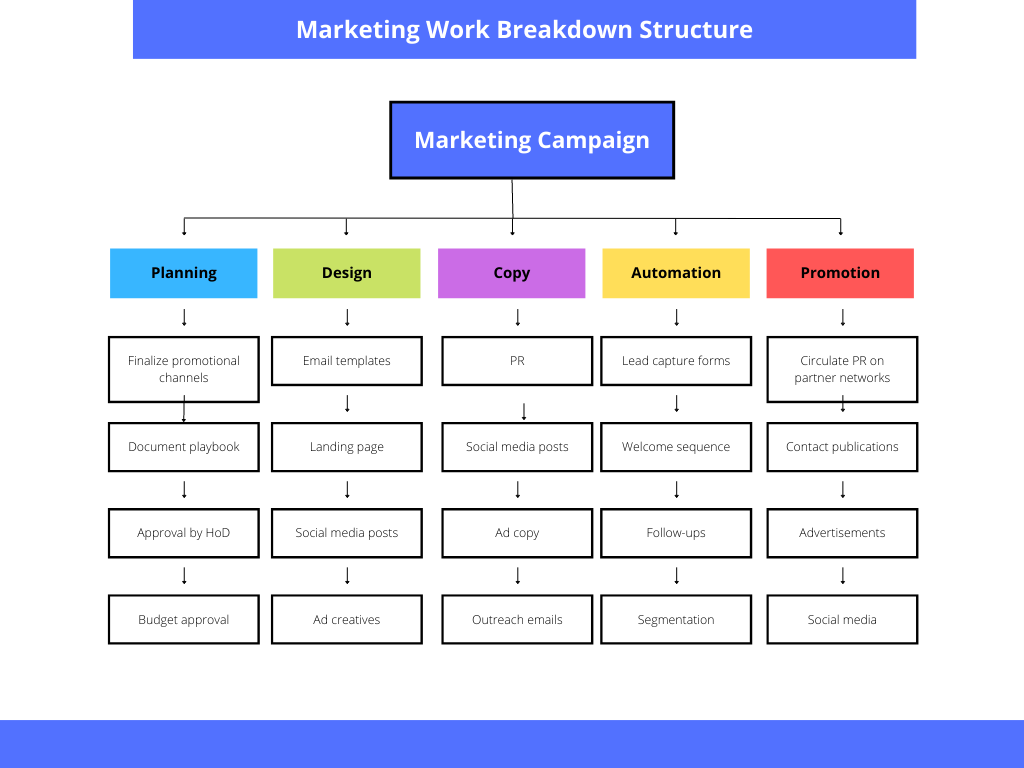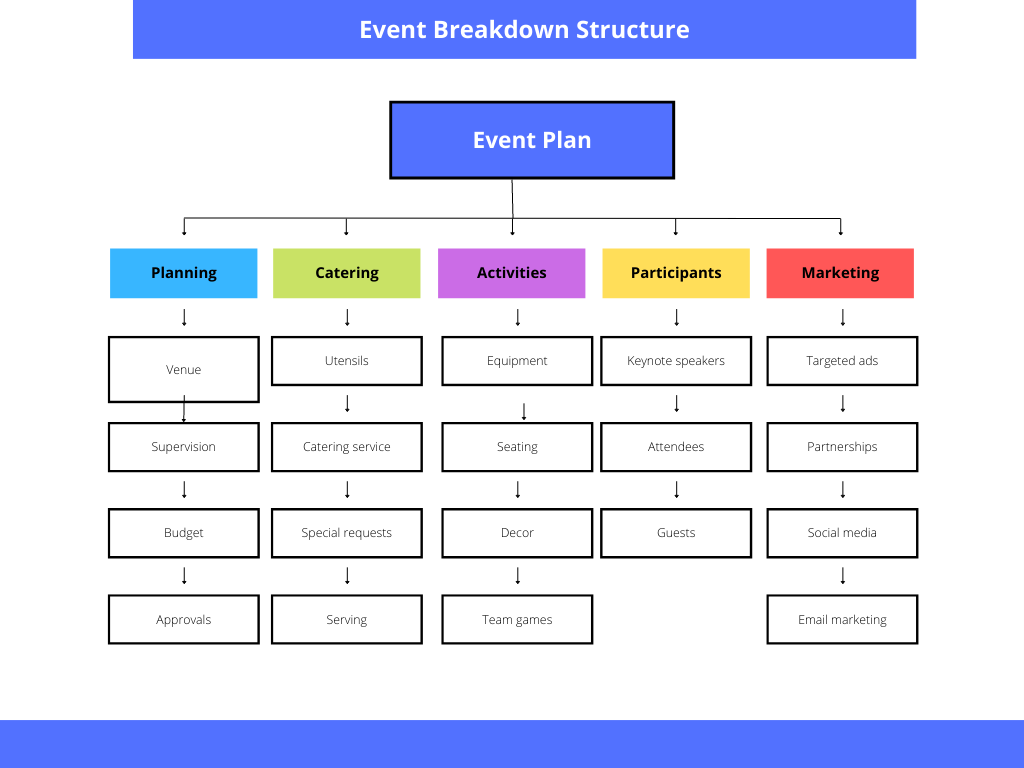If you’re looking for a structured method for organizing your projects, outlining workflows, assigning responsibilities, and estimating resource requirements, a work breakdown structure (WBS) might be just what you need. A WBS helps you visualize your project, assess its scope, and decompose your core deliverables into smaller, more manageable tasks.
In this article, we’ll explore how you can create and manage work breakdown structures for all your projects.
🎓 CAFLOU® academy is brought to you by CAFLOU® - 100% digital project and business management software
What is a work breakdown structure (WBS)?
A work breakdown structure is precisely what it sounds like – a systemic breakdown of the different tasks and deliverables needed to complete a given project. Breaking your projects down into smaller, more manageable components helps you track progress, ensure accountability, and better allocate resources.
Work breakdown structures are typically of two types:
1. Deliverables-based. In this type of WBS, the first ‘level’ of work breakdown elements includes a summary of the project’s deliverables. These deliverables may include a product, services, or defined targets/results.
2. Phase-based. A phase-based WBS divides a project into different stages. In this case, the first level of your breakdown will include the stages.
Deliverables-based structures are the more common type of WBS – and they’re perfect for visualizing a project’s scope. You can choose to display your WBS in different ways, like as a flowchart, list, spreadsheet, or Gantt chart.
The layout and structure of a WBS
Before you create your work breakdown structure, you’ll need to:
- Collect documentation and content relevant to the project, which may include expectations set by the client, the project charter or roadmap, the scope statement, etc.
- Identify relevant team members who are best suited to work on the project. You might want to consider each team member’s skill set and project history to determine who’s a good fit for the new project.
Now, before you create your first WBS, let’s clear two terms up:
- Project levels. A WBS has different ‘levels’, and each level breaks the previous level down into more manageable tasks and deliverables. So, level 1 elements will include your project’s core deliverables, but your level 2 elements will include smaller, more manageable tasks corresponding to each level 1 element.
- Decomposition. This is when you break down the deliverables from one level to smaller deliverables in the next level. It’s effectively breaking down your ‘work’ and structuring it further, making it easier to track and assign responsibilities. It’s important to avoid decomposing your project too much, because this may increase the amount of effort required to manage it.
You’re now ready to create your WBS, and the first step is to define your level 1 elements–i.e., the project’s main deliverables. Your level 1 elements should summarize your project deliverables, and they should cover your entire project’s scope. Then, proceed to ‘decompose’ each element until you achieve a subset of smaller tasks/deliverables where each element can be managed by an individual/single department or team.
To give you more clarity, let’s take a look at some examples of WBS in action.
3 Examples of WBS in action
Let’s take a look at how we can create our own work breakdown structures.
1. WBS for a marketing campaign
For a marketing campaign, let’s consider a deliverables-based WBS. Let’s set our level 1 elements as:
- Planning
- Design
- Copy
- Automation
- Promotional channels
Now, we need to decompose each level 1 element into tasks and deliverables that an individual can own. For example, in the planning phase, we’d want to:
- Plan out which channels we’ll use for marketing. For example, do we want to invest in SEO? Is paid social a consideration, or shall we exclusively stick to organic social?
- Document a playbook that details our marketing strategy, relevant to each channel and each product or service. The playbook should also tie our marketing activities together.
- Approval by Head of Department (HoD)/director of marketing.
- Budget approval. Running ads comes at a cost, you might need cash to hire external help (freelancers, consultants), etc.
Here’s an example of a general marketing campaign WBS:

2. WBS for an event
- Planning
- Location
- Speakers
- Promotion channels
- Registration
- Post-event engagement
Now, just as we did for the marketing campaign, let’s decompose these level 1 elements further:

These individual elements can now be assigned to different team members.
3. WBS for software development project
Let’s consider a general software development WBS that you can tweak and use for any development project. First, you’ll need to define the level 1 elements. For a phase-based WBS, these elements are the different stages of the project, which include planning, design, development, testing, deployment, and maintenance. You’ll then need to decompose these phases into different tasks and deliverables, similar to how we’ve done it for deliverables-based WBS.
5 benefits of using a WBS for project management
Just how effective is a WBS for managing your projects? Here are five reasons to consider using one.
1. Manage and delegate responsibilities
A WBS lets you break a project down into responsibilities that individuals can manage–which really helps ensure accountability. Everyone on the team knows exactly what they’re supposed to work on, and what results they own.
Moreover, a WBS helps you assign tasks and deliverables to the right person every time. You can make sure that each deliverable is delegated to a team member with the most relevant skills and experience, ensuring your team members play to their strengths.
2. Organize workflows and track progress
You can display your WBS in different ways – using a flow or Gantt chart, spreadsheet, etc. – but, provided you properly decompose your level 1 elements, your finished WBS is an excellent visual representation of your workflows. It allows project managers, team members, and clients to understand the entire project’s lifecycle – and who’s involved – at a glance.
A breakdown structure also helps you track progress as your project develops. You can continuously monitor results to make sure your goals are met at the right time, and when bottlenecks arise, you’ll know where to look (and who to ask about them).
3. Improve collaboration and communication
Although the goal of a WBS is to outline mutually exclusive deliverables that individuals can manage, having visibility of the entire project is crucial. Your team members need to know how their work fits into the project’s scope, who to contact for information regarding a specific deliverable/task, work that’s been completed and work that’s left, etc.
A WBS provides a visual representation of the project’s deliverables hierarchy, helping team members access all the details about the project’s scope in one centralized place.
4. Estimate costs, time, and resource requirements
Estimating the costs and staff requirements for a project is difficult if you don’t break it down. For example, think of a mobile app or a marketing campaign. Can you tell how much it would take to develop, say, a role-playing game (RPG) for smartphones? Or how many team members you’d need to run a special holiday marketing campaign?
Until you break the required work down into smaller packages, you won’t be able to make accurate estimations. But if you decompose your project, e.g., if you break your marketing campaign down into deliverables like graphics, ad copy, social media posts, automated email templates, press release, etc., you can make far more accurate estimations about the staff and cost requirements.
5. Identify and minimise risks
Just as breakdowns help you make more accurate estimations, they also give you a clearer overview of the risks associated with a project. Decomposing your project into work packages helps you prepare for the risks associated with different elements–and you can make individuals responsible for the risks that concern their specific tasks/deliverables. You can also sort risks by their ‘threat level’ and prioritize them accordingly.
Another powerful way that work breakdown structures assist in risk management is by creating an organized, visual foundation for building a risk breakdown structure (RBS). An RBS outlines the entire scope of a project’s risk, including the probability of different risks’ occurrence and their impact. Since a WBS outlines your project’s scope and decomposes each deliverable, it can help you build an accurate RBS.

Leverage Caflou to create and manage your work breakdown structures
Caflou’s project management module lets you create work breakdown structures to manage your projects in one place. With Caflou, you can:
1. Design breakdowns with unlimited levels
Decompose your projects until you have one individual responsible for each deliverable. Assign tasks and deliverables to the best-fit team member based on their skills and experiences.
2. Toggle between different project views
Kanban, WBS, Gantt charts, tasks to be done, budgets or expenses, you name it. Caflou lets you view your projects in your preferred format to quickly access the information you need.
3. A fully integrated platform
Work breakdown structures give you complete visibility into your project’s scope, operations, resources, and progress – but Caflou helps you achieve the same for your entire business. Use Caflou to manage essential business functions like financial planning and forecasting, budgets, customer relationships, projects, workflows, and more.
Start building your work breakdown structures with Caflou today. Get started for free.
<< Back to all articles in the series Caflou Project Management Academy